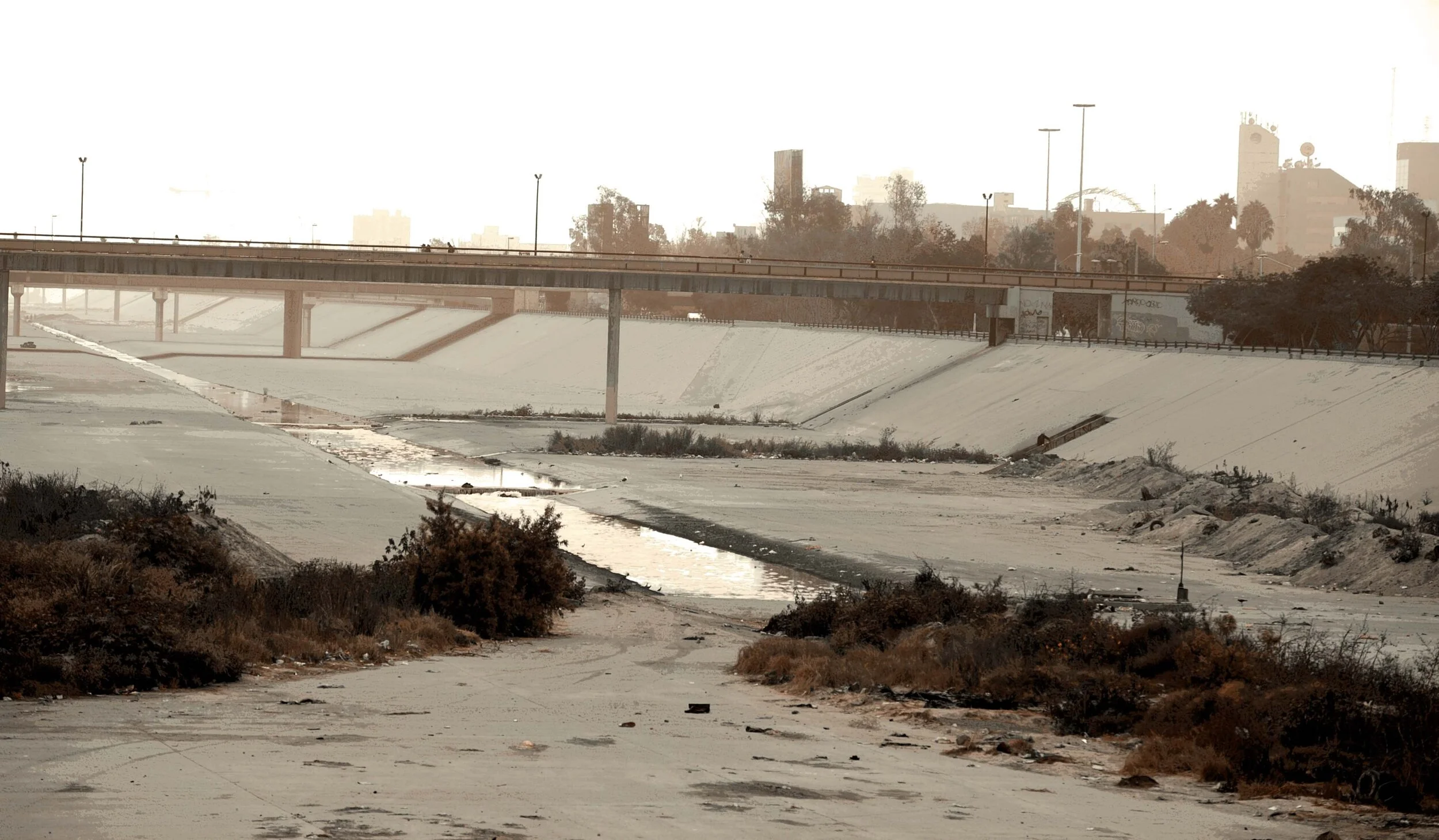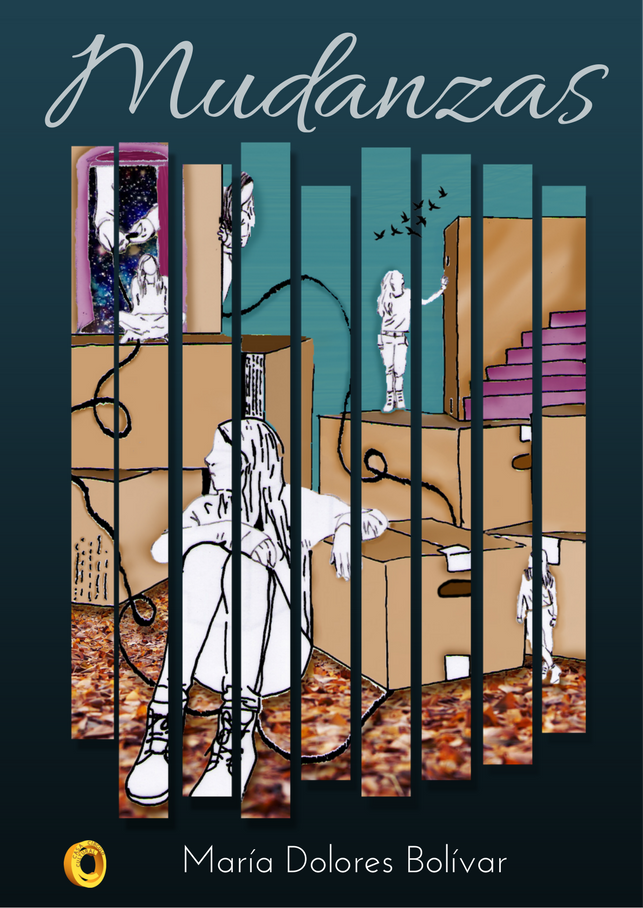Fiction/Poetry
Río Tijuana. Un Aqueronte moderno y sórdido. Photo by María Dolores Bolívar.
Río, para después el mar. (Flow, inexorably out to sea.)
Many believe cities must have a river to be reputable; so it is not too far fetched to assume that there cannot be poetry without reference to one or more rivers. Río, para después el mar (Flow, inexorably out to sea) turns all rivers, real and mythic, into the needed tools to navigate through life.
Many of the poems in the anthology Río, para después el mar were published separately, so the cohesive idea in rearranging them together is the notion of a river that runs, much like inland waterways flow on to the sea. To grow up in Mexico City kept Bolivar from enjoying the abundance of rivers like Balsas, Lerma or Panuco. She felt deprived when facing the Seine or the Guadalquivir, knowing that Mexico City should have outshone Venice with it colorful and flowery canals, and all its liquid extravagance. Instead, Mexico City had all waterways channeled and its lakes and canals emptied.
In Río, para después el mar, the allegory of Acheron, the mythic river that divides life and death comes in handy to describe the border, where rivers flow moving sediments of sorrow; and where travelers drown, when waters rise; or are forced to dig themselves into the dry riverbed for survival. In Río, para después el mar, each poem is a raft or the rowboat that will help the reader reach the riverbank safe; survive the drought; be moved by the current.
¿The ocean? The ocean is a giant –a turbulent healer; the final thunderous peace. In Spanish the word río (river) also means to laugh; and laughter here is taken as a restorative and liberating force; one that helps travelers flow, and survive. Bolivar grew up far from el Chamizal –the utmost symbol of a shifting border-, but all her life she wanted to visit it. When she finally did, she understood, first hand, how much that arm of the Bravo/Grande, altered courses, defining a lot more than the individual lives/countries it touched.
* * *
Para muchos no hay ciudad respetable que no tenga un río; así que no resulta muy jalado asumir que no puede haber poesía sin referencia a uno o más ríos. Río, para después el mar (Flow, inexorably out to sea) vuelve todos los ríos, reales y míticos en herramientas necesarias para navegar la vida. Casi todos los poemas de la antología Río, para después el mar fueron originalmente publicados por separado, de ahí que para dar cohesión a ese re acomodo venga a colación el río que, desde tierra adentro, fluye hacia el mar.
Crecer en la ciudad de México privó a Bolívar de disfrutar de la abundancia de ríos como el Balsas, el Lerma o el Pánuco. El despojo lo sintió sobre todo frente al Sena o el Guadalquivir, sabedora de que la ciudad de México pudo haber superado a Venecia con sus canales florecientes y coloridos y toda su extravagancia líquida. Pero la ciudad de México entubó sus ríos y vació sus lagos y canales.
En Río, para después el mar, la alegoría del Aqueronte, el mítico río que divide a la vida de la muerte, resulta útil para describir a una frontera en donde los ríos mueven depósitos de dolor y guían a los viajeros ya sea a ahogarse, cuando las aguas suben; o a atravesar su fondo seco, para sobrevivir. En Río, para después el mar, cada poema es una balsa, o un barco de remos que ayudará al lector a llegar a la orilla, a salvo; sobrevivir a la sequía, verse arrastrado por la corriente.
¿El océano? El océano es un gigante -un turbulento sanador; esa paz tormentosa del final. En español la palabra río es también risa; y la risa aquí es fuerza restauradora y liberadora; es lo que ayuda a los viajeros a fluir y sobrevivir. Bolívar creció muy lejos de El Chamizal -el símbolo inequívoco de una frontera cambiante-, pero toda su vida quiso visitarlo. Cuando por fin estuvo ahí, entendió, en carne propia, cuanto ese brazo del Bravo/Grande alteran cursos, definen mucho más que esas vidas individuales o esos países que tocan.
Mudanzas, empacar lo que no esté roto
(Moves, Pack What Isn't Broken -short story-)
A collection of short stories about moving, from house to house, and from country to country. Bolivar, an immigrant in the United States since she was a teen-ager, has made border living the all-encompassing theme of her writing. Bolivar contends her writing represents historic events inasmuch as real incidents tend to be recycled into fiction through storytelling. And as they leave the privacy of individual lives and homes, characters and stories become composites, reconstructed through memory and chatter; and more the work of collective imagination than individual craft. A journalist at heart, Bolivar claims that most literary work came about through the impact most stories have on the way people go through life with wide-open eyes. And as these stories help us retrace and understand the laxity and ever moving quality of that vast realm referred to as the border, they also reveal the normalcy that drives individuals to come and go, from side to side, as if no barrier or wall, or bilateral regulation ever stood in their way. Stretching through times and tales, Mudanzas helps you travel across the border at ease, knowing that each end of your path mirrors the other, somehow.
***
Colección de cuentos reunida en torno al tema de ir, de casa en casa de país en país. Bolívar, que inmigró a Estados Unidos siendo adolescente, ha hecho de la vida en la frontera el tema subyacente de su escritura. Bolívar sostiene que su escritura se entrevera con la historia en la medida en que la ficción resulta de la recuperación de incidentes contados en voz alta. Al dejar el círculo privado de los individuos y sus casas, los personajes se vuelven un compuesto reconstruido a partir de la memoria y las pláticas; urdidos más en base a la imaginación colectiva que a la talla solitaria. Periodista de corazón, Bolívar sustenta que el trabajo literario se forja a partir del impacto que las historias tienen en su manera de hacer que la gente vaya por la vida con ojos bien abiertos. Y a medida en que son los cuentos lo que nos ayuda a repasar y entender lo laxo y móvil de esa vastedad a la que se refiere como línea fronteriza, estos revelan también la normalidad que guía a los individuos en sus ires y venires, de lado a lado, tal y como si no hubiese barreras, murallas o reglamentos bilaterales que les estorbasen. Al recorrer tiempos y cuentos, Mundanzas te llevará a cruzar esa línea fronteriza con desenfado, sabedor de que cada extremo de esa ruta opera cual espejos cuyos interiores se reflejaran uno a otro, de alguna manera.

